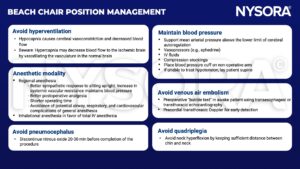Learning objectives
- Describe the advantages and risks of the beach chair position
- Manage patients presenting for surgery in the beach chair position
Background
- Patients are often positioned in the beach chair or sitting position for shoulder surgery, fossa craniotomy, and post-c-spine surgery
Advantages
- Improved surgical access
- Decreased brachial traction injury
- Ease of setup and conversion to an open approach
- Decreased risk of bleeding
Risks
- Hypotension
- Decrease in cerebral perfusion
- Venous air embolism
- Paradoxical air embolism
- Excessive neck flexion
- Bradycardia or cardiac arrest
- Macroglossia
- Upper airway obstruction
- Pneumocephalus
- Subdural hematoma
- Quadriplegia
- Stroke
Management
Management of patients presenting for surgery in the beach chair position comprises minimizing the risk of complications, mainly by maintaining cerebral perfusion

Suggested reading
- Murphy GS, Greenberg SB, Szokol JW. Safety of Beach Chair Position Shoulder Surgery: A Review of the Current Literature. Anesth Analg. 2019;129(1):101-118.
- Hewson DW, Oldman M, Bedforth NM. Regional anaesthesia for shoulder surgery. BJA Education. 2019;19(4):98-104.
- Rozet I, Vavilala MS. Risks and benefits of patient positioning during neurosurgical care. Anesthesiol Clin. 2007;25(3):631-x.
We would love to hear from you. If you should detect any errors, email us customerservice@nysora.com







